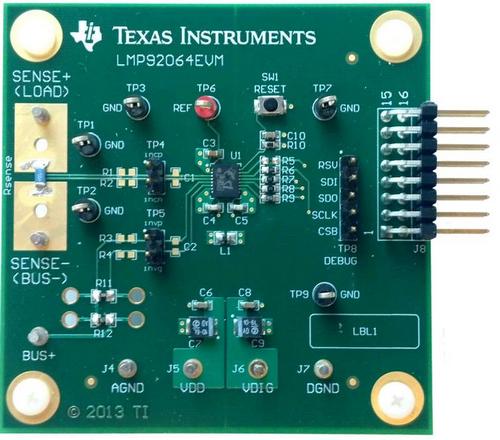Evaluation Module Texas Instruments LMP92064EVM
The LMP92064EVM is a demonstration kit for the LMP92064, a precision low-side digital current sensor and voltage monitor with a digital SPI interface.
Detailed Description
The evaluation kit includes a USB2ANY interface board, and software is available to allow the evaluation platform to run with a PC user interface.
The LMP92064 integrates a precision current sense amplifier and two 12-bit analog-to-digital converter (ADC) channels that simultaneously capture voltage and current data, while the SPI interface transfers real-time data at up to 20 MHz. This enables the device to provide the highest precision power calculations of any device on the market today. The LMP92064 is used in applications where precise power monitoring is crucial, such as communications infrastructure applications, including telecom, servers and central office equipment.
Features
- Industry-leading accuracy: The combination of simultaneous sampling, maximum input offset voltage of ±15 uV, and maximum gain error of less than ±0.75 percent delivers unparalleled accuracy compared to the competition.
- Fastest conversion rate: The 125-ksps conversion rate is 19 times faster than the competition, which allows designers to measure power fluctuations more accurately.
- Higher bandwidth: Designers can communicate with the device using a four-wire SPI interface at speeds up to 20 MHz, which is six times faster than the nearest competitor's I2C interface.
- Easy isolation barrier interface: The unidirectional input and output lines enable easy interfacing to isolation devices, such as the ISO7141CC quad-channel digital isolator.
- Simultaneous current and voltage sensing for precise power monitoring
- On-board sense resistor for out-of-the-box readiness.
- Dual channel data capture and display
- Ability to export data in comma-separated value format for post processing
- Evaluation software compatible with MicrosoftTM Windows XP or Windows 7

